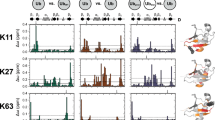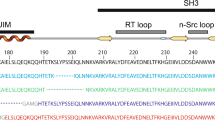Abstract
Mechanisms of protein recognition have been extensively studied for single-domain proteins1, but are less well characterized for dynamic multidomain systems. Ubiquitin chains represent a biologically important multidomain system that requires recognition by structurally diverse ubiquitin-interacting proteins2,3. Ubiquitin chain conformations in isolation are often different from conformations observed in ubiquitin-interacting protein complexes, indicating either great dynamic flexibility or extensive chain remodelling upon binding. Using single-molecule fluorescence resonance energy transfer, we show that Lys 63-, Lys 48- and Met 1-linked diubiquitin exist in several distinct conformational states in solution. Lys 63- and Met 1-linked diubiquitin adopt extended ‘open’ and more compact ‘closed’ conformations, and ubiquitin-binding domains and deubiquitinases (DUBs) select pre-existing conformations. By contrast, Lys 48-linked diubiquitin adopts predominantly compact conformations. DUBs directly recognize existing conformations, but may also remodel ubiquitin chains to hydrolyse the isopeptide bond. Disruption of the Lys 48–diubiquitin interface changes conformational dynamics and affects DUB activity. Hence, conformational equilibria in ubiquitin chains provide an additional layer of regulation in the ubiquitin system, and distinct conformations observed in differently linked polyubiquitin may contribute to the specificity of ubiquitin-interacting proteins.
This is a preview of subscription content, access via your institution
Access options
Subscribe to this journal
Receive 51 print issues and online access
$199.00 per year
only $3.90 per issue
Buy this article
- Purchase on Springer Link
- Instant access to full article PDF
Prices may be subject to local taxes which are calculated during checkout




Similar content being viewed by others
References
Lo Conte, L., Chothia, C. & Janin, J. The atomic structure of protein-protein recognition sites. J. Mol. Biol. 285, 2177–2198 (1999)
Komander, D. & Rape, M. The ubiquitin code. Annu. Rev. Biochem. 81, 203–229 (2012)
Husnjak, K. & Dikic, I. Ubiquitin-binding proteins: decoders of ubiquitin-mediated cellular functions. Annu. Rev. Biochem. 81, 291–322 (2012)
Hershko, A. & Ciechanover, A. The ubiquitin system. Annu. Rev. Biochem. 67, 425–479 (1998)
Chen, Z. J. & Sun, L. J. Nonproteolytic functions of ubiquitin in cell signaling. Mol. Cell 33, 275–286 (2009)
Iwai, K. Linear polyubiquitin chains: a new modifier involved in NFκB activation and chronic inflammation, including dermatitis. Cell Cycle 10, 3095–3104 (2011)
Komander, D., Clague, M. J. & Urbé, S. Breaking the chains: structure and function of the deubiquitinases. Nature Rev. Mol. Cell Biol. 10, 550–563 (2009)
Cook, W. J., Jeffrey, L. C., Carson, M., Chen, Z. & Pickart, C. M. Structure of a diubiquitin conjugate and a model for interaction with ubiquitin conjugating enzyme (E2). J. Biol. Chem. 267, 16467–16471 (1992)
Ryabov, Y. & Fushman, D. Interdomain mobility in di-ubiquitin revealed by NMR. Proteins 63, 787–796 (2006)
Tenno, T. et al. Structural basis for distinct roles of Lys63- and Lys48-linked polyubiquitin chains. Genes Cells 9, 865–875 (2004)
Hirano, T. et al. Conformational dynamics of wild-type Lys-48-linked diubiquitin in solution. J. Biol. Chem. 286, 37496–37502 (2011)
Varadan, R. et al. Solution conformation of Lys63-linked di-ubiquitin chain provides clues to functional diversity of polyubiquitin signaling. J. Biol. Chem. 279, 7055–7063 (2004)
Komander, D. et al. Molecular discrimination of structurally equivalent Lys 63-linked and linear polyubiquitin chains. EMBO Rep. 10, 466–473 (2009)
Rohaim, A., Kawasaki, M., Kato, R., Dikic, I. & Wakatsuki, S. Structure of a compact conformation of linear diubiquitin. Acta Crystallogr. D 68, 102–108 (2012)
Orte, A., Clarke, R., Balasubramanian, S. & Klenerman, D. Determination of the fraction and stoichiometry of femtomolar levels of biomolecular complexes in an excess of monomer using single-molecule, two-color coincidence detection. Anal. Chem. 78, 7707–7715 (2006)
Fraser, J. S. et al. Hidden alternative structures of proline isomerase essential for catalysis. Nature 462, 669–673 (2009)
Newton, K. et al. Ubiquitin chain editing revealed by polyubiquitin linkage-specific antibodies. Cell 134, 668–678 (2008)
Rahighi, S. et al. Specific recognition of linear ubiquitin chains by NEMO is important for NF-κB activation. Cell 136, 1098–1109 (2009)
Sato, Y. et al. Structural basis for specific cleavage of Lys 63-linked polyubiquitin chains. Nature 455, 358–362 (2008)
McCullough, J. et al. Activation of the endosome-associated ubiquitin isopeptidase AMSH by STAM, a component of the multivesicular body-sorting machinery. Curr. Biol. 16, 160–165 (2006)
Ye, Y. et al. Polyubiquitin binding and cross-reactivity in the USP domain deubiquitinase USP21. EMBO Rep. 12, 350–357 (2011)
Wiener, R., Zhang, X., Wang, T. & Wolberger, C. The mechanism of OTUB1-mediated inhibition of ubiquitination. Nature 483, 618–622 (2012)
Juang, Y.-C. et al. OTUB1 co-opts Lys48-linked ubiquitin recognition to suppress E2 enzyme function. Mol. Cell 45, 384–397 (2012)
Boehr, D. D., Nussinov, R. & Wright, P. E. The role of dynamic conformational ensembles in biomolecular recognition. Nature Chem. Biol. 5, 789–796 (2009)
Eddins, M. J., Varadan, R., Fushman, D., Pickart, C. M. & Wolberger, C. Crystal structure and solution NMR studies of Lys48-linked tetraubiquitin at neutral pH. J. Mol. Biol. 367, 204–211 (2007)
Schaefer, J. B. & Morgan, D. O. Protein-linked ubiquitin chain structure restricts activity of deubiquitinating enzymes. J. Biol. Chem. 286, 45186–45196 (2011)
Thrower, J. S., Hoffman, L., Rechsteiner, M. & Pickart, C. M. Recognition of the polyubiquitin proteolytic signal. EMBO J. 19, 94–102 (2000)
Orte, A., Clarke, R. W. & Klenerman, D. Fluorescence coincidence spectroscopy for single-molecule fluorescence resonance energy-transfer measurements. Anal. Chem. 80, 8389–8397 (2008)
Clarke, R. W., Orte, A. & Klenerman, D. Optimized threshold selection for single-molecule two-color fluorescence coincidence spectroscopy. Anal. Chem. 79, 2771–2777 (2007)
Acknowledgements
We would like to thank members of the Komander, Jackson and Klenerman laboratories, R. Williams, S. Freund, C. Johnson, S. McLaughlin and A. Fersht for discussions. Work in the Komander laboratory is supported by the Medical Research Council (U105192732) and the EMBO Young Investigator Program. G.B. and S.I. were supported by the BBSRC, the Newton Trust and an EMBO YIP small grant to D.Ko. Work in the Klenerman laboratory is supported by EPSRC.
Author information
Authors and Affiliations
Contributions
Y.Y., G.B. and M.H.H. designed and performed the experiments, including single-molecule measurements, and analysed the data. Y.Y. and G.B. generated all proteins used in this study. Y.Y. performed kinetic experiments. M.H.H. and S.I. built the PAX instrument and A.A.Z. programmed the control for PAX measurements. S.I. performed single molecule experiments and contributed to data analysis. M.J.R.-R. and A.O. performed lifetime measurements. D.Kl., S.E.J. and D.Ko. directed the research and analysed the results. All authors contributed to the writing of the manuscript.
Corresponding authors
Ethics declarations
Competing interests
The authors declare no competing financial interests.
Supplementary information
Supplementary Information
This file contains Supplementary Figures 1-13, Supplementary Methods and Supplementary References. (PDF 3875 kb)
Rights and permissions
About this article
Cite this article
Ye, Y., Blaser, G., Horrocks, M. et al. Ubiquitin chain conformation regulates recognition and activity of interacting proteins. Nature 492, 266–270 (2012). https://doi.org/10.1038/nature11722
Received:
Accepted:
Published:
Issue Date:
DOI: https://doi.org/10.1038/nature11722
This article is cited by
-
Phosphorylation of USP27X by GSK3β maintains the stability and oncogenic functions of CBX2
Cell Death & Disease (2023)
-
Parkin-mediated ubiquitination inhibits BAK apoptotic activity by blocking its canonical hydrophobic groove
Communications Biology (2023)
-
Structural basis of bacterial effector protein azurin targeting tumor suppressor p53 and inhibiting its ubiquitination
Communications Biology (2023)
-
A bifunctional molecule-assisted synthesis of mimics for use in probing the ubiquitination system
Nature Protocols (2023)
-
Plant deubiquitinases: from structure and activity to biological functions
Plant Cell Reports (2023)
Comments
By submitting a comment you agree to abide by our Terms and Community Guidelines. If you find something abusive or that does not comply with our terms or guidelines please flag it as inappropriate.



